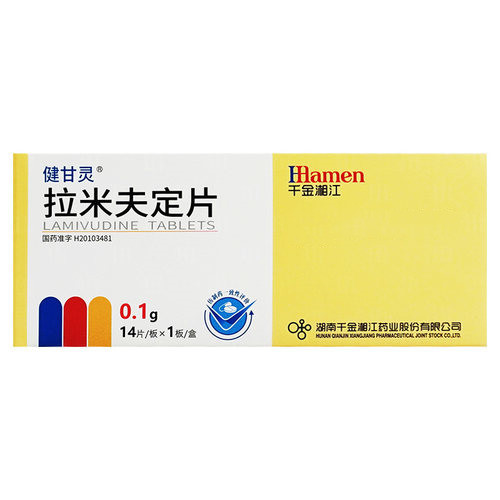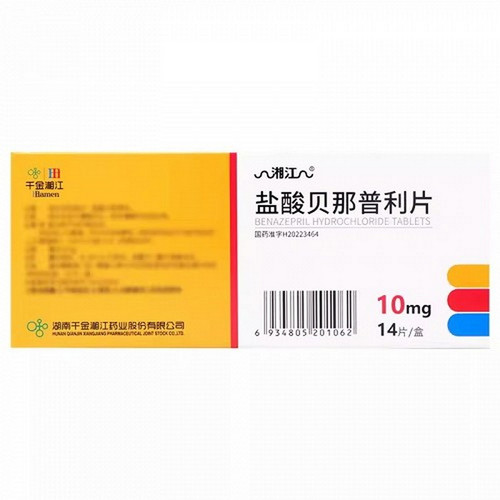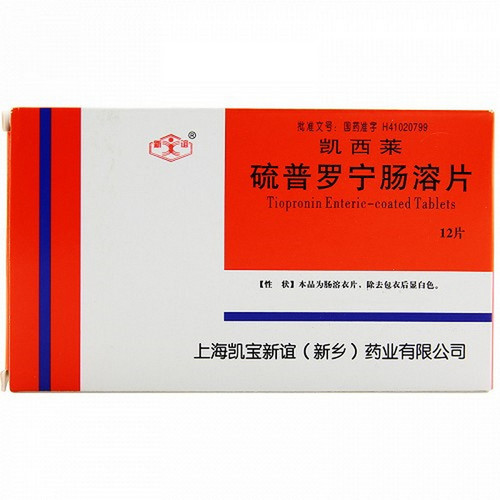Product Overview
[Drug Name]
Generic Name: Lamivudine Tablets
Trade Name: Jianganling
English Name: Lamivudine Tablets
Chinese Pinyin: LaMiFuDingPian
[Ingredients]
Lamivudine
[Appearance]
Film-coated tablets, appear white after removing the film coating.
[Indications]
Indicated for the treatment of adult patients with chronic hepatitis B who have elevated alanine aminotransferase (ALT) levels, viral activity, and compensated liver function.
[Dosage]
Oral administration: Adults, 0.1 g once daily.
[Adverse Reactions]
Common adverse reactions include upper respiratory tract infection-like symptoms, headache, nausea, malaise, abdominal pain, and diarrhea. Symptoms are generally mild and resolve spontaneously.
[Contraindications]
1. This product is contraindicated in patients with allergies. 2. This product should not be used by patients under 3 months of pregnancy. Pregnant and lactating women should use with caution.
[Precautions]
1. Patients should be reminded that lamivudine is not a cure for hepatitis B. Patients must take lamivudine under the guidance of a specialist experienced in hepatitis B treatment. Patients should not discontinue lamivudine on their own and should undergo regular monitoring during treatment. ALT levels should be measured at least every three months, and HBV DNA and HBeAg should be measured every six months. 2. Patients who are HBsAg-positive but have normal ALT levels should not initiate lamivudine treatment, even if HBeAg and/or HBV DNA are positive. Regular follow-up should be performed and reconsidered based on the course of their condition. 3. With prolonged lamivudine treatment, the YMDD variant of hepatitis B virus may be detected in some patients, and this variant is less sensitive to lamivudine.
[Use in Special Populations]
Precautions for Pediatric Use:
There are no data on the use of lamivudine in children in China.
Precautions for Pregnancy and Lactation:
This product should not be used by patients within three months of pregnancy. Pregnant and lactating women should use it with caution.
Precautions for Elderly Patients:
For elderly patients with decreased renal excretion due to aging, lamivudine metabolism is not significantly altered. This effect is only seen when creatinine clearance is <30 ml/min.
[Drug Interactions]
Due to the low drug metabolism and plasma protein binding of this drug, and its primary renal elimination as unchanged drug, the potential for interactions with other drug metabolites is very low. Lamivudine is primarily eliminated as an active organic cation. Interactions should be considered when used concomitantly with drugs that share the same excretion mechanism, particularly when the primary route of elimination is active renal secretion via the organic cation transport system (e.g., trimethoprim). Studies have shown that some other drugs eliminated via this mechanism (e.g., ranitidine, cimetidine) do not interact with lamivudine. Drugs that are primarily eliminated as active organic anions or via glomerular filtration are unlikely to interact with lamivudine to any significant degree. Coadministration of lamivudine with trimethoprim (160 mg)/sulfamethoxazole (800 mg) increases lamivudine exposure by 40%. However, lamivudine does not affect the pharmacokinetic properties of trimethoprim/sulfamethoxazole. Therefore, unless the patient has renal impairment, no lamivudine dosage adjustment is necessary. When lamivudine is coadministered with zidovudine, a modest increase in zidovudine Cmax of approximately 28% is observed, but no significant change in systemic bioavailability (area under the concentration-time curve, AUC) is observed. Zidovudine does not affect the pharmacokinetic properties of lamivudine (see Pharmacokinetics). There are no pharmacokinetic interactions between lamivudine and interferon-gamma (α-IFN) when used concurrently; no interactions between lamivudine and commonly used immunotherapies have been observed clinically.
[Pharmacological Action]
Pharmacological Action: Lamivudine is a nucleoside analog that is phosphorylated intracellularly to lamivudine triphosphate (L-TP). This cyclic adenosine monophosphate (cAMP) is incorporated into viral DNA by hepatitis B virus (HBV) polymerase, leading to DNA strand synthesis arrest. Lamivudine triphosphate is a weak inhibitor of mammalian α-, α-, and α-DNA polymerases. In vitro, the half-life of lamivudine triphosphate in hepatocytes is 17-19 hours. Lamivudine is an antiviral drug that has demonstrated inhibitory activity against HBV in various experimental cell lines and infected animal models. However, two of these animal models (ducklings and black mice) exhibited activity against HBV. Chimpanzees) showed a rebound in serum DNA levels of hepatitis B virus within 4 and 14 days after stopping treatment with this product, respectively. Long-term use of lamivudine can lead to a decrease in the sensitivity of HBV to it. Virus strain genotype analysis showed that this change was related to the replacement of methionine at position 552 of the YMDD sequence in the catalytic reaction region of HBV polymerase by valine or isoleucine, and the replacement of leucine at position 528 by methionine. In vitro, the replication ability of HBV recombinants containing YMDD mutations was lower than that of wild-type HBV. It is not clear whether other mutations of HBV are related to its decreased in vitro sensitivity to lamivudine. Toxicological studies Genetic toxicity Lamivudine did not show mutagenic activity in microbial mutagenicity tests and in vitro cell transformation experiments, but showed its microbial activity in in vitro cultured human lymphocytes and mouse lymphoma experiments. Weak mutagenic activity. Rats were orally administered lamivudine 2000 mg/kg (blood concentration is 60-70 times the recommended clinical dose for patients with chronic hepatitis B), and no obvious genetic toxicity was observed. Reproductive toxicity Rats were orally administered lamivudine 4000 mg/kg/day (blood concentration is 80-120 times the human clinical blood concentration), and their fertility and the survival, growth, and development of the offspring after weaning were not significantly affected. Rats and rabbits were orally administered lamivudine 4000 and 1000 mg/kg/day, respectively (blood concentration is approximately 60 times the human clinical recommended dose blood concentration), and neither showed obvious teratogenic effects. When the rabbit blood concentration is close to the human clinical recommended dose blood concentration, an increase in early embryonic mortality occurs. However, when the rat blood concentration reaches the equivalent of the human clinical recommended dose blood concentration This phenomenon was not observed at 60 times the dose of lamivudine. Studies in pregnant rats and rabbits have shown that lamivudine can cross the placenta and enter the fetus. There are no adequate and rigorously controlled clinical studies of lamivudine use in pregnant women. Lamivudine concentrations in lactating rat milk are similar to those in plasma. Carcinogenicity: Long-term carcinogenicity studies in rats and mice showed no significant carcinogenicity at exposure levels 34 times (mice) and 200 times (rat) the human clinical exposure level.
Storage: Protect from light, seal tightly, and store in a cool, dry place.
Specifications: 0.1g
Packaging: 0.1g x 14 tablets
Expiry Life: 24 months
Approval Number: National Medicine Standard H20103481
Manufacturer: Hunan Qianjin Xiangjiang Pharmaceutical Co., Ltd.









